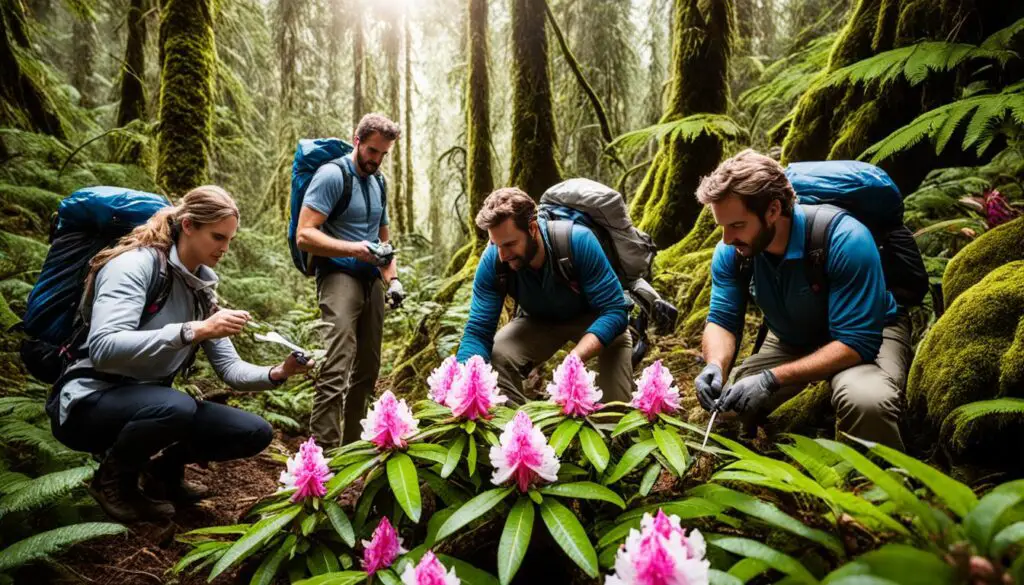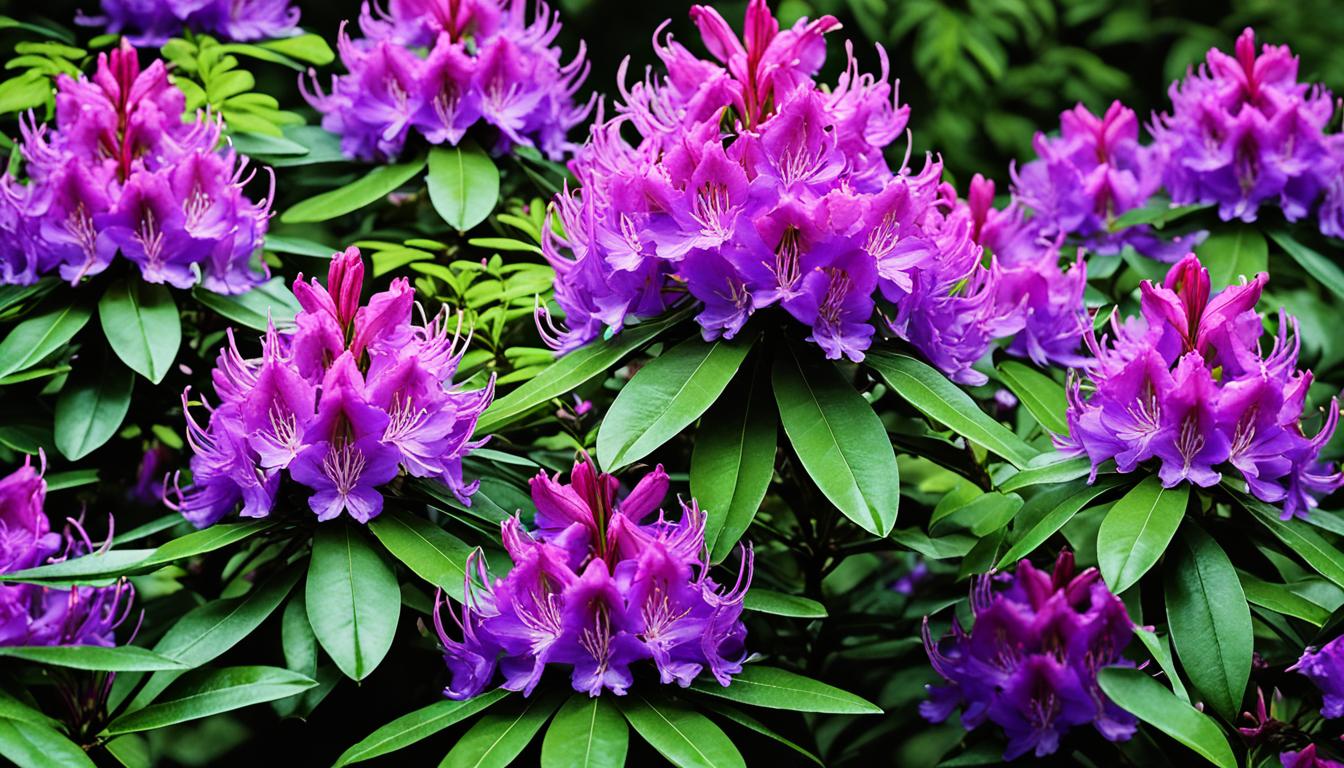Rhododendron occidentale is also called the western azalea. It’s found naturally in California. This beautiful plant stands out with its shiny green leaves and sweet-smelling flowers. It’s a favorite among people who love nature and gardening. Let’s dive into the world of Rhododendron occidentale. We’ll see why it’s so loved.
Key Takeaways:
- Rhododendron occidentale, also known as the western azalea, is a native rhododendron species found in California.
- It features glossy mid-green foliage that turns orange and yellow in autumn.
- The fragrant, funnel-shaped flowers are predominantly white, sometimes tinged with pink, and have yellow blotches within.
- It can grow up to 3m tall and blooms in early summer.
- Rhododendron occidentale thrives in moist, well-drained, acidic soil and prefers partial shade.
Characteristics of Rhododendron Occidentale
Rhododendron occidentale is a bushy, leaf-losing shrub, growing up to 3 meters tall. It is part of the rhododendron family, coming from California. This plant is admired for its shiny leaves, sweet-smelling blooms, and eye-catching looks.
One special trait of Rhododendron occidentale is its glossy mid-green leaves. They are smooth and bright, bringing elegance to the shrub. In fall, the foliage changes to orange and yellow, showing off vivid colors.
The flowers of Rhododendron occidentale are captivating. These funnel-shaped blossoms can be up to 10cm wide and have a lovely scent. They are mostly white, but some may show a light pink color. Yellow marks inside the flowers make them unique.
These stunning blooms appear in the early summer. They display beautiful white and pink colors. The flowers’ fragrance is magical and attracts bees and butterflies.
To sum up, Rhododendron occidentale is a deciduous shrub known for its shiny leaves and sweet-smelling white blooms. Its bright colors and pleasant scent add great value to gardens.
Growth and Cultivation of Rhododendron Occidentale
The western azalea, or Rhododendron occidentale, is a beautiful shrub that grows 1.5-2.5 meters tall and wide. It’s loved by gardeners for its stunning looks and flexibility in landscapes.
This plant does well in moist, acidic, well-drained soil. Keeping the soil moist helps the plant grow and bloom beautifully. It’s also best to give it some shade to protect it from harsh sun in the summer.
You can grow Rhododendron occidentale in a few ways, including seeds, cuttings, layering, and grafting. The end of summer is great for seeds and cuttings. For layering, choose autumn. Late summer or winter works for grafting.
Pruning is key for a healthy and well-shaped western azalea. It’s in pruning group 1, so prune right after it blooms. This lets it grow new for next season. At this time, also remove any dead or damaged branches and shape the shrub.
Tips for successful cultivation:
- Provide moist, well-drained soil with an acidic pH.
- Ensure partial shade to protect the plant from direct sunlight.
- Choose a suitable location with west-facing, east-facing, or south-facing aspects.
- Use propagation methods like seed, semi-ripe cuttings, layering, or grafting for propagation.
- Prune according to pruning group 1 immediately after flowering to encourage new growth and abundant blooms.
Following these tips will help you grow a strong and beautiful Rhododendron occidentale. It will be a standout part of your garden.
Hardy Rating and Botanical Details
The western azalea, or Rhododendron occidentale, is quite a captivating plant. It’s known for its toughness, with a hardiness rating of H6. This means it can handle cold down to -20 to -15 degrees Celsius. Such resilience makes it a favorite in the UK and northern Europe.
This shrub is part of the Ericaceae family and drops its leaves every year. Its deciduous nature lets us see its changing colors. In autumn, it turns vibrant orange and yellow, beautifying landscapes.
However, the western azalea has a downside. It’s harmful if eaten. Don’t touch its leaves, flowers, or any parts without protection. Always wear gloves to avoid skin reactions.
Botanical Details at a Glance
| Botanical Detail | Description |
|---|---|
| Hardiness Rating | H6 |
| Family | Ericaceae |
| Foliage | Deciduous |
| Potentially Harmful | Yes |
Here’s a quick look at the key traits of Rhododendron occidentale. These include its H6 hardiness rating and its place in the Ericaceae family. It’s also worth noting its deciduous nature and that it can be harmful.
The Smith-Mossman Western Azalea Garden
The Smith-Mossman Western Azalea Garden is a tribute to Britt Smith and Frank Mossman’s hard work. They loved plants and worked hard to protect Rhododendron occidentale. They identified about 275 unique western azaleas over fifteen years, helping us learn more about these plants.
Smith and Mossman didn’t just study these plants, they made sure they were safe. They kept many plants at their homes in Washington. They also moved some to the Lake Wilderness Arboretum to share their work with others.
Today, this garden has the world’s biggest collection of Rhododendron occidentale. These plants show the deep love and knowledge Smith and Mossman had for them.

A Remarkable Preservation Effort
Preserving plants is very important in horticulture. People like Britt Smith and Frank Mossman are key. They collected many types of Rhododendron occidentale. This work helps protect these plants for the future.
Their work does more than just keep the plants safe. It helps us understand them better. This includes their looks, how they grow, and how they adapt. This information also helps scientists and gardeners learn more, helping us take care of plant species.
A Living Legacy
The Smith-Mossman Western Azalea Garden is more than just a garden. It inspires people who love plants. Anyone visiting can enjoy the Rhododendron occidentale and see what Smith and Mossman achieved.
The garden holds many plants, showing us how much Smith and Mossman loved them. Their work lets us see how special the Rhododendron occidentale is.
Looking at the Smith-Mossman Western Azalea Garden, we see their great work. It also makes us think about how important it is to protect our natural world.
The Importance of Detailed Notes
Britt Smith and Frank Mossman were serious about their Rhododendron studies. They gave each unique rhododendron a special Smith-Mossman number. Their careful notes are a rich source of information. They recorded where each plant was found, when it bloomed, and what the flowers looked like.
Their notes detailed flower color, size, and how many blossoms each one had. They also noted any special features of the plants. This made it easier for others to spot these unique rhododendrons in nature.
Thanks to their hard work, we know more about the different types of Rhododendron occidentale. Anyone who wants to study or just appreciate these plants can use their notes.
Smith-Mossman Record Numbers
| Record Number | Location | Bloom Time | Flower Details | Distinctive Features |
|---|---|---|---|---|
| SM 001 | Coastal Mendocino County | Early summer | White flowers with pink tinge; yellow blotches | Deeply cut foliage |
| SM 028 | Crescent City, California | Mid-summer | Double-flowered | – |
| SM 053 | Siskiyou County, California | Late spring | Pale pink flowers; deeply cut lobes | Compact growth habit |
The Smith-Mossman Western Azalea Garden Today
In 1997, Britt Smith and his wife Jean decided to move. They took their azalea collection to the Lake Wilderness Arboretum. This began a fresh chapter for their cherished rhododendrons.
By 2000, the garden had been named the Smith-Mossman Western Azalea Garden. It now has the biggest collection of Rhododendron occidentale in the world. There are more than 200 kinds to see.
When people visit, they see a stunning floral display from late spring to summer. The Rhododendron occidentale offers amazing colors and sweet smells.
In 2008, the garden got a makeover. It added Pacific Northwest native plants. These plants now live in harmony with the rhododendrons, adding to the garden’s beauty and diversity.
Notable Selections of Western Azalea
The Smith-Mossman collection features several notable western azalea selections. They highlight the Rhododendron occidentale species’ diversity. These unique choices add beauty and depth to gardens. Noteworthy selections include:
SM 28 – Double-Flowered Plants
SM 28 is known for its double-flowered plants found near Crescent City, California. They feature layers of petals, offering delicate beauty. Their lavish blooms become the highlight of any garden.
SM 30 'Crescent City Gold’ – Yellow-Flowered Azalea
SM 30 'Crescent City Gold’ is notable for its bright, yellow flowers. This vibrant variety adds a pop of color to gardens. It lights up beds and borders with its golden blossoms.
SM 53 – Unique and Deeply Cut Floral Lobed
SM 53 is unique for its deeply cut floral lobes. This special trait distinguishes it from others, adding artistry to its look. It brings an intriguing touch to the plant’s appearance.
SM 148 – Large-Flowering Western Azalea
SM 148 features large, showy flowers. These blooms are notably big, drawing eyes with their stunning beauty. They lend elegance and a sense of awe to any garden.
SM 157 'Miniskirt’ – Small-Sized Rhododendron
SM 157 'Miniskirt’ is a charming, small-sized western azalea. It fits well in compact spaces or small gardens. Despite its small size, it blooms abundantly, delighting all who see it.
These western azalea selections from the collection show the Rhododendron occidentale species’ range. There are choices for everyone, from double flowers to bright yellows, unique cuts, large blooms, or tiny beauties. These plants will satisfy any garden lover.
Preservation and Availability
It’s critical to preserve the Smith-Mossman collection’s western azaleas, given their rarity today. These plants can be hard to root. Plus, their seedlings often look different from the parent. Luckily, moving the collection to the Lake Wilderness Arboretum protects these plants for the future.
Finding these unique azaleas at specialist nurseries can be tough. Getting the best Rhododendron occidentale needs patience. Because of their unique traits, people really want these plants. So, it’s vital to look for nurseries that have these rare finds.
The Smith-Mossman Western Azalea Garden is key in keeping these plants’ diversity and beauty alive. It ensures these amazing selections are available for all to enjoy. This garden helps keep the stunning Rhododendron occidentale admired by many.
